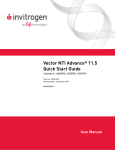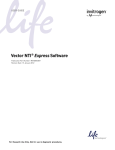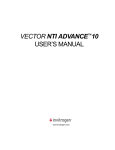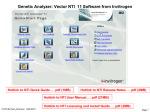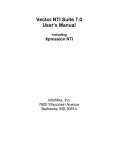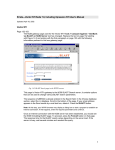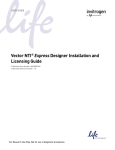Download Vector NTI Advance 11 Quick Start Guide
Transcript
Vector NTI Advance™ 11 Quick Start Guide Catalog no. 12605050, 12605099, 12605103 Version 11.0 December 15, 2008 12605022 Published by: Invitrogen Corporation 5791 Van Allen Way Carlsbad, CA 92008 U.S.A. www.invitrogen.com Copyright © 2008 Invitrogen Corporation. All rights reserved. This document contains proprietary information of Invitrogen Corporation. No part of this document, including design, cover design, and icons, may be reproduced or transmitted in any form, by any means (electronic, photocopying, recording, or otherwise) without prior written agreement from Invitrogen Corporation. The software described in this document is furnished under a license agreement. Invitrogen Corporation and its licensors retain all ownership rights to the software programs offered by Invitrogen Corporation and related documentation. Use of the software and related documentation is governed by the license agreement accompanying the software and applicable copyright law. Vector NTI Advance and Gateway are trademarks of Invitrogen Corporation in the United States and other countries. Logos of Invitrogen Corporation are also trademarks registered in the United States and may be registered in other countries. Other product and brand names are trademarks of their respective owners. Generated in the United States. Invitrogen Corporation reserves the right to make and have made changes, without notice, both to this publication and to the product it describes. Information concerning products not manufactured or distributed by Invitrogen Corporation is provided without warranty or representation of any kind, and neither Invitrogen Corporation nor its affiliates will be liable for any damages. 2 Table of Contents Introduction........................................................................................................................................... 4 Opening Vector NTI Advance™ 11....................................................................................................... 5 Local Database ..................................................................................................................................... 6 Database Backup/Restore ................................................................................................................... 7 Molecule Viewer.................................................................................................................................... 8 Selecting and Editing Molecule Sequences ...................................................................................... 9 Designing PCR Primers from a Sequence ....................................................................................... 10 Clone Two Fragments with Clone2Seq ............................................................................................11 In-Silico Gene Synthesis with ReGENerator.................................................................................... 12 Identifying Open Reading Frames (ORFs) ....................................................................................... 13 Creating a Restriction Map ................................................................................................................ 14 Aligning Molecules............................................................................................................................. 15 Contig Assembly ................................................................................................................................ 16 Additional Information ....................................................................................................................... 18 3 Introduction This Quick Start Guide is designed to get you started using Vector NTI Advance™ 11. It provides brief descriptions of the Vector NTI Advance™ 11 graphical user interface, including Vector NTI Explorer and the Molecule Viewer, and step-by-step instructions for using the most common features and functions of the software. The topics covered include locating the desired tools, displaying molecules, designing PCR primers, cloning two fragments, gene synthesis, aligning molecules, performing a restriction analysis, and assembling contigs. This guide assumes that you have a working knowledge of basic Microsoft® Windows® and Mac OS® features and functions (how to open and save files, how to use your mouse, and so on) and that Vector NTI Advance™ 11 is installed on your computer. 4 Opening Vector NTI Advance™ 11 The QuickStart Page is a single page that consolidates most commonly used modules, tools, and utilities that Vector NTI Advance provides. To launch the QuickStart Page, select Start > All Programs > Invitrogen > Vector NTI Advance 11 > Quick Start. Figure 1. QuickStart Page You can configure the software to open both the Molecule Viewer and Vector NTI Explorer when you select Vector NTI from the Start menu. 1. In the Molecule Viewer window, go to the Edit menu and select Options. 2. In the General tab of the dialog, select the Open Local Explorer At Startup checkbox. 3. Click OK to make the change. 5 Local Database Vector NTI Explorer is the main tool for accessing the information in your local Vector NTI Advance™ database. Using the Explorer, you can import, open, export, and organize molecules and other database items, and launch other Vector NTI Advance™ modules (Figure 2). To launch Vector NTI Explorer: • On QuickStart Page, click on Local Database. • In the Molecule Viewer, click on the Local Database icon ( • From the Windows® Start menu, select Programs | Invitrogen | Vector NTI Advance 11 | Vector NTI Explorer. • The local database in Vector NTI Advance™ contains records for different types of molecular biology objects. Each database record includes all the information for that object (e.g., a DNA molecule record includes the DNA sequence, defined features of the molecule, and other information). Objects in the database can include molecules, analysis results, BLAST search results, citations, and other types of information. ). Import/create molecules Display/analyze molecules Import analysis results Export molecules Import BLAST results Launch tools List of database records Database object type Figure 2. Vector NTI Explorer (Local Database) window. Database objects in Vector NTI Advance™ are categorized by type (DNA molecules, protein molecules, and so on). Some molecules are installed with the software. When you first open the software, DNA/RNA Molecules is the selected object type. Click on the tab in the lower left corner of the Vector NTI Explorer to select from the other available database objects. To open an object from the local database, double-click on the object name in the right-hand pane of the Explorer. Depending on the object type, information about that object may be displayed in a dialog box, or the object may be loaded into a viewer. For example, DNA, RNA, and protein molecules are displayed in the Molecule Viewer. When you install Vector NTI Advance™, the default local database is created in a folder called VNTI Database in the root directory of your computer (e.g., C:\VNTI Database). 6 Database Backup/Restore It is strongly recommended that the local database be backed up routinely. You may launch the Database Backup manually, or use the Database Backup Reminder to trigger the task automatically as configured (Figure 3). To manually perform Database Backup: • From the Vector NTI Explorer menu, select Database | Backup Database Now. To configure the Database Backup Reminder: • From the Vector NTI Explorer menu, select Database | Database Backup Reminder. • To set a specific date or interval (e.g., backup every 15 days), click on Set Reminder. Figure 3. Database Backup To restore a database: • From Vector NTI Explorer menu, select Database | Database Restore. Figure 4. Database Restore 7 Molecule Viewer The Molecule Viewer displays information about DNA, RNA, and protein molecules. To launch the Molecule Viewer: • Click on Molecule Viewer on the QuickStart page, or • From the Windows® Start menu, select Programs | Invitrogen | Vector NTI Advance 11 | Vector NTI, or • Double-click on a molecule name in the Vector NTI Explorer. To open a molecule from within the Molecule Viewer, click on the Open button ( toolbar and select the molecule name from the dialog box. ) on the main The molecule will be loaded into the Molecule Viewer. Pane-specific tools Text Pane (info about features, restriction sites, etc.) Graphics Pane Sequence Pane Figure 5. Molecule Viewer window for a DNA molecule. The Molecule Viewer window has different panes for displaying different types of information about the molecule, as shown in Figure 5. Click inside a pane to make it the active pane. The available tools and right-click menu options will change depending on which pane is active. Use tools on the dropdown menus and toolbars to add information about the molecule and perform various analysis functions, as described in the step-by-step instructions on the following pages. Multiple molecules can be displayed in separate windows of the Molecule Viewer. 8 Selecting and Editing Molecule Sequences In the Molecule Viewer, you can select part of a molecule sequence in several different ways: • Hold down the mouse button and drag the cursor across the sequence in the Sequence Pane or Graphics Pane (Figure 6). • Go to the Edit menu, select Set Selection, and enter the sequence base-pair range in the dialog box. • Click on a defined feature in the Graphics Pane. • Click on a defined feature in the Text Pane, and click on Find ( ) on the main toolbar. The selected sequence will appear highlighted in both the Graphics Pane and the Sequence Pane. (1) (2) Figure 6. Selecting a DNA sequence by (1) dragging in Graphics Pane or (2) dragging in Sequence Pane. To copy a molecule sequence: 1. Select it as described above. 2. To copy it to the Windows® clipboard, use the CTRL + C keyboard command, or To copy the sequence as a text file, go to the Edit menu and select Copy to > File. You will be prompted to select a format and enter a name for the file. To delete a molecule sequence: 1. Select it as described above. 2. Click on the DELETE key on your keyboard. To paste a molecule sequence: 1. With the sequence in text format on the Windows® clipboard, click on the point in the Sequence Pane where you want to add the insert. 2. Click on CTRL + V on your keyboard. 3. The Insert Sequence dialog will open, displaying the sequence to be inserted. 4. Click on OK to complete the insertion. 9 Designing PCR Primers from a Sequence Vector NTI Advance™ 11 can analyze a selected sequence and design PCR primers for it, based on parameters such as desired melting temperature (Tm), GC content, and amplicon length. With a DNA or RNA molecule open in the Molecule Viewer: 1. Select the part of the sequence for which you want to design primers, as described on the previous page. 2. Go to the Primer Design menu. 3. Select Find PCR Primers to find primers within the sequence (Figure 7), or Select Amplify Selection to find primers in the regions before and after the sequence (other amplification selections are available; see the Vector NTI Advance™ 11 User’s Manual for more information). 4. In the dialog box, select the desired primer-design parameters. Note that most of these parameters have default values based on typical PCR primers. 5. Click on OK. The results will appear under PCR Analysis in the Text Pane. PCR analysis results Figure 7. Designing PCR primers within a selected region. To save the PCR analysis results as a separate object in the database: 1. Right-click on the PCR Analysis folder in the Text Pane. 2. Select Save as Analysis Result. The saved results will be listed under the Analysis Results object type in the Vector NTI Explorer (Figure 8). Figure 8. PCR analysis results listed in Vector NTI Explorer. 10 Clone Two Fragments with Clone2Seq Clone2Seq offers the easiest way to clone two fragments. To use Clone2Seq: 1. In the Molecule Viewer, go to Cloning | Clone2Seq, or click on the Clone2Seq button ( the main toolbar. 2. To load Insert and/or Vector, click on Load Molecule. 3. Select fragment by Restriction Site by clicking on Site #1, shift-clicking on Site #2 on each molecule. 4. Make sure the left terminus of the first fragment is compatible with the right terminus of the second fragment, and the right terminus of the first fragment is compatible with the left terminus of the second fragment. 5. Add selected fragments by clicking on Add Fragment. 6. Click on Clone. Figure 9. Clone 2 fragments with Clone2Seq. 11 ) on In-Silico Gene Synthesis with ReGENerator ReGENerator offers the fastest way to build your desired DNA from the ground up, optimized for expression, with any amino acid mutation you want, and with the flanking sequences you need for expression, purification, or detection. Then, right from your desktop, send your DNA sequence to our partner Blue Heron® Bio’s secure server for rapid synthesis. To design the DNA from an amino acid sequence: 1. With the source protein molecule loaded in the Molecule Viewer, select Cloning | ReGENerator or click on the ( ) icon on the main toolbar. 2. Mutate the protein molecule by inserting, deleting, or replacing single or multiple amino acids. 3. Select the desired Codon Usage Table for the organism. 4. Select the desired Genetic Code. 5. You may also add attachment sequences to the terminus of the DNA: • Choose terminus (5’ or 3’) • Choose Attachment Type 6. To view the back-translated DNA, click View Molecule. 7. To send the DNA sequence for synthesis at Blue Heron®, click Send for Synthesis. Figure 10. In-Silico Gene Synthesis with ReGENerator. 12 Identifying Open Reading Frames (ORFs) Vector NTI Advance™ 11 can analyze a DNA/RNA molecule and identify the open reading frames (ORFs) in it, based on start and stop codons within the molecule. With a DNA or RNA molecule open in the Molecule Viewer: 1. Go to the Analyses menu and select ORF (Figure 11). 2. In the dialog box, select the parameters for identifying and marking ORFs in the molecule. 3. When you click on OK, the sequences identified as ORFs will be marked with directional arrows in the Graphics Pane and Sequence Pane, and the ORFs will be listed in the Text Pane. 4. To identify an ORF in the different panes: 5. • Click on a directional ORF arrow in the Graphics Pane to highlight its sequence in the Sequence Pane, or • Open a folder under Open Reading Frames in the Text Pane, right-click on the ORF name, and select Find ORF to highlight it in the Graphics and Sequence Panes. To save an ORF to the feature map of the molecule, right-click on the ORF arrow in the Graphics Pane or the ORF folder in the Text Pane, and select Add ORF to FMap. ORF marked in Graphic pane Figure 11. Identifying ORFs 13 Creating a Restriction Map Vector NTI Advance™ 11 can analyze a DNA/RNA molecule and identify the restriction sites in it, using the software’s comprehensive library of restriction enzymes. With a DNA or RNA molecule open in the Molecule Viewer: 1. Go to the Analyses menu and select Restriction Analyses > Restriction Sites (Figure 12). 2. In the Restriction Map Setup dialog, review the list of restriction enzymes in the Use Enzymes: field. These are the enzymes that will be used to identify the restriction sites. Click on the < Add, > Remove, and >> Remove All buttons to add and remove enzymes from the list. Note: If you click on < Add, the Choose Database Enzymes dialog will open, listing all the enzymes in the database. Select enzymes in the list by clicking on them or click on the Select All button, and then click on the OK button to add them to the Restriction Map Setup dialog. 3. Click on OK in the Restriction Map Setup dialog. The restriction enzymes and their binding sites will be shown in the Graphics Pane and Sequence Pane. The specific cut site of each enzyme will be listed under Restriction/Methylation Map in the Text Pane. Rest. site shown in Graphics Pane Rest. site shown in Sequence Pane Figure 12. Creating a Restriction Map. 14 Aligning Molecules Vector NTI Advance™ 11 can align the sequences of two or more DNA/RNA molecules. The tool for doing this is called AlignX. This tool can be launched from either the Molecule Viewer or Vector NTI Explorer. To align sequences using Vector NTI Explorer: 1. In the Explorer, select the molecules that you want to align using SHIFT + CLICK or CTRL + CLICK key commands (Figure 13). 2. Go the Align menu and select AlignX—Align Selected Molecules. The AlignX Window will open, with the molecules you selected listed in the upper left Text Pane. 3. In the AlignX Window, use SHIFT + CLICK or CTRL + CLICK key commands to select two or more molecules in the Text Pane list to align. 4. ) on the toolbar. The alignment may To begin the alignment, click on the Align button ( take several minutes, depending on the length and number of the molecules selected. 5. When the alignment is complete, the results are displayed in the AlignX Window, as shown in Figure 13. The AlignX Window has panes showing different similarity graphs and the points at which the sequences align. Complexity and similarity plots Relatedness tree Sequence alignment Figure 13. Aligning molecules. 15 Contig Assembly Vector NTI Advance™ 11 can be used to assemble DNA fragments—both text sequences and chromatograms from automated sequencers—into longer contiguous sequences or “contigs.” The tool for doing this is called ContigExpress. In Vector NTI Explorer or the Molecule Viewer: 1. Go to the Assemble menu and select ContigExpress—Open New Assembly Project (Figure 144). 2. In the ContigExpress Project Explorer, go to the Project menu and select Add Fragments >. Select your fragment file type from the submenu list. The Import Sequence dialog will open. 3. In the Import Sequence dialog, navigate to the directory containing your fragment sequence files. Select the files and click on Open. 4. Depending on the file type, you may be prompted to list the fragments by their Windows® file names or by their internal fragment names. Select the desired option. The fragments will be loaded in the ContigExpress Project Explorer. 5. To view a particular fragment, double-click on it in the Project Explorer list. It will be loaded into the Fragment Viewer. 6. When you are ready to perform contig assembly, select the fragments in the ContigExpress Project Explorer. 7. Click the Assemble Selected Fragments icon ( ) on the main toolbar. Fragments will be analyzed and assembled into one or more contigs, which will be listed in the Project Viewer along with the fragments in each contig. 8. Double-click on a contig in the list. It will be displayed in the Contig Viewer. The Sequence Pane at the bottom shows the sequence of the assembly. The Graphics Pane on the right shows the orientations of the fragments in the assembly. The Text Pane on the left lists the fragments in the assembly. 9. If you wish to edit the contig, enable the Enhanced Edit Mode by clicking the icon Use Enhanced Edit Mode (far left on the toolbar in the Contig window) before making any reasonable changes. 10. There are three trimming options in ContigExpress. Fragments can be trimmed for ambiguities, Phred quality scores, and vector contamination. Refer to the Vector NTI Advance™ 11 User’s Manual for details. Continued on the following page 16 Contig Assembly, continued Fragment Viewer Figure 14. Assembling a Contig 17 Additional Information Invitrogen's free technical support for Vector NTI Advance 11 is available exclusively through the web. For more information, check out the Software Support section of the Vector NTI website at http://www.invitrogen.com/VectorNTI. To obtain personalized technical support by telephone or email, you must have an annual support contract. You may purchase an Advanced Support Contract by contacting Invitrogen at [email protected]. To receive technical support, use the following contacts: United States Phone: 800-955-6288 x 67990 (Toll-free, U.S.) E-mail: [email protected] Europe, Middle East, Africa, Asian Pacific Phone: +44 781 696 2707 Email: [email protected] 18




















